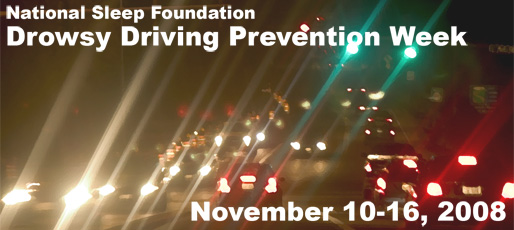The National Sleep Foundation (NSF) has announced that it will recognize its 2nd annual “Drowsy Driving Prevention Week” (DDPW) during the week of November 10-16, 2008. The NSF is an independent, science-based, nonprofit health organization of physicians, scientists, researchers and other sleep professionals dedicated to improving public health and safety by achieving a greater understanding of sleep and sleep disorders. The NSF furthers its mission through public education, research and advocacy initiatives. One of these initiatives is “Drowsy Driving Prevention Week” which NSF sponsors to raise public awareness about the dangers of driver fatigue and drowsy driving.

“Drowsy Driving Prevention Week” was first recognized in November 2007. At that time, NSF launched a new website: www.drowsydriving.org. On that website, readers can find more information about the dangers of drowsy driving and ways to help increase public awareness about this serious national safety problem. That website also features testimonials from victims whose lives have been permanently affected by a drowsy driving or sleep related crash. Moreover, every year during “Drowsy Driving Prevention Week,” NSF plans to release on its drowsydriving.org website an annual survey about progress being made on specific issues related to drowsy driving prevention and law enforcement. Ragland Law Firm, LLP agrees that driver fatigue and drowsy driving is a serious traffic safety concern. Therefore, the firm fully supports the efforts of NSF to raise awareness about this problem through its “Drowsy Driving Prevention Week,” and related education and prevention campaigns.

Numerous studies have shown that fatigue and/or sleepiness significantly impairs a person’s ability to safely operate a motor vehicle. Drowsy drivers have slowed reaction times, impaired judgment, diminished motor skills, more difficulty with information processing, and a tendency toward more aggressive driving behaviors. One study performed by the AAA Foundation for Traffic Safety concluded that compared to drivers who had gotten 8 hours or more of sleep, people who had slept less than 7 hours are twice as likely to cause a motor vehicle accident, and people sleeping less than 5 hours increased the risk of a crash four to five times. Researchers in Australia claim that being awake for 18 hours produced an impairment equal to a blood alcohol concentration (BAC) of .05, and sleep deprivation of 24 hours produced impairment equivalent to that of a drunk driver with a BAC of .10 which is above the legal limit of .08 in Georgia and all across America.
Continue reading →
 Georgia Injury Attorney Blog
Georgia Injury Attorney Blog

